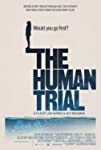Eye For Film >> Movies >> The Human Trial (2022) Film Review
The Human Trial
Reviewed by: Jennie Kermode

A lot of parents shy away from letting their children know anything about blood and medicine and mortality until age or circumstance means there’s no avoiding it. For those who are chronically ill, there’s no avoiding it. In practice kids tend to take it in their stride like everything else, and in the opening scene of this film we see a boy sitting with his mother as she checks her blood sugar levels. he’s learning to make sense of numbers by reading the monitor with her. She’s a type-1 diabetic.
For people with diabetes, day to day life is full of dangers. Even with a well controlled diet and insulin regime, blood sugar levels can swing unpredictably. The results of this can be catastrophic. Then, even for those who are lucky enough to be relatively stable, there’s all the hassle of having to deal with injections and constant monitoring. Type-1 diabetes presents at birth, so people with that variant have never had the chance to enjoy freedom from such things. With this in mind, it’s clear why the idea of getting a bio-artificial pancreas implanted might be appealing.

Many years in development, this implant is a lot simpler than it might sound. It’s a plastic device which houses stem cells from the patient’s own body – cells which have been cultured to produce insulin like a natural, healthy pancreas. In theory, it could allow diabetics to live as freely as anyone else and never have to worry about their blood sugar levels again, but there’s still quite a bit of refinement needed, not to mention making sure that there are no serious side effects, and to that end, now that testing in mice has proved successful, it’s time for a human trial.
Lisa Hepner and Guy Mossman’s documentary follows this trial and the people participating it. Though it includes quite a bit of science, it’s all pitched at a level with the average intelligent person can understand, so you won’t need a scientific background to find it accessible. It is seen, primarily, from the point of view of the participants, looking at their reasons for participating, their hopes and their fears, and following through the long gruelling months. Whilst many clinical trials simply involve taking pills, in this case repeated surgeries are needed so that the implants can be removed from the body and examined. The cells they contain won’t ladt forever – no cell in the body does – but the hope is that they will become the basis of a cluster of new ones. It’s probably not too much of a spoiler to say that not everything goes perfectly for all of those involved. There are disappointments, the psychological impact of which can be considerable. Some of the participants try to balance these against the hope for other people which the wider trial represents.
A look back at the history of diabetes treatment explains why it’s all so important. Before the discovery of insulin and the development of injectable preparations, the only way to treat it was by trying to keep the body free from sugars – including those found naturally in most types of food. In essence, it was a starvation diet. Old photographs show what it did to the bodies of those affected. Part way through the film, Jack, the boy we saw at the start, is taken to visit the Flame of Hope, which was lit in 1989 and will burn until a cure for diabetes is found.
How does a trial like this one come about? Hepner illustrates the amount of prior work that has gone into the development of the device with a literal heap of research papers strewn across a desk. There is discussion of funding – of the extortionate cost of diabetes treatments in the US, and on the cost of research (allowing that many studies fail to produce useful results). This feels a little bit disingenuous given that, whilst it might be a fair argument when used more generally, insulin in particular is comparatively cheap to produce and has notoriously been price hiked to the point where people have died due to their inability to afford it. The subsequent discussion of funding is wholly focused on the private sector, ignoring other options, but is interesting insofar as it goes an can contribute towards a more balanced understanding of the issue.
Overall, this is a fascinating piece of work which efficiently outlines the bio-artificial pancreas trial whilst raising awareness of diabetes and proving a much broader overview of the processes through which new drugs become available. If you’re thinking of participating in a clinical trial yourself, no matter for what kind of treatment, you are likely to find it extremely useful both in informing your decision and, should you choose to go ahead, in helping you to prepare yourself for the difficulties and disappointments which may arise. Furthermore, as it places clinical trials in context, it will help people more generally to understand why it takes so long to go from a brilliant idea to a useful end product (unless, as in the Case of Covid, one is bumped to the front of the queue for every bit of paperwork).
When diabetes is finally defeated, this film will be an important contribution to our understanding of the processes through which that came about. In the meantime, it is a tribute to the scientists, doctors and volunteers who are doing their bit to get us there.
Reviewed on: 20 Jun 2022

















